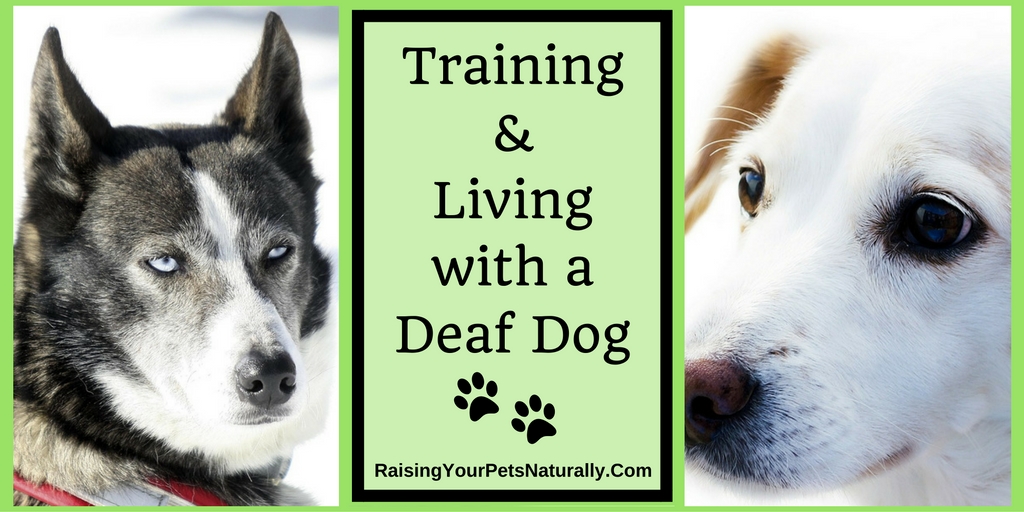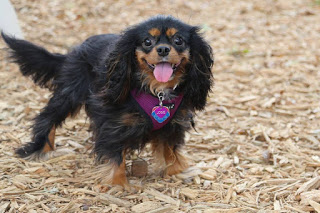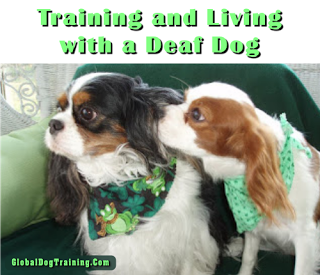Google Adsense—>

Living and Training a Deaf Dog
Positive Dog Training for Deaf Dogs

Lately, I have been getting a lot of questions about training a deaf dog and how to ensure a deaf dog is living a happy and productive life. So, today is the day that I will tackle this question. The good news is that it’s really not that difficult to train a deaf dog. Dogs in general respond better to visual cues vs. voice prompts. But before I get into the how-to of training a deaf dog, let me discuss a few other things that may enter the picture when living with a deaf dog.

- Rupert
Born Deaf: There is a variety of reasons a dog may be born deaf. Genetic defects can affect a dog’s hearing, especially dogs with a white pigmentation. Infections, medications, and toxic exposures during or soon after birth can also cause deafness. When a dog is born deaf, he’s actually at an advantage over a dog who becomes deaf. A deaf puppy typically does not go through the stress of losing his hearing as an adult dog can.
Becoming Deaf: A dog can lose his hearing for a variety of reasons. A dog may become deaf from gradual hearing loss due to old age, exposure to loud noises, untreated ear infections, injury to the ear canal, or even certain medications.
Over my years as a dog trainer, I have worked with various pet parents and their dogs during their hearing loss. Some dog owners are aware of what is going on, others are surprised when I suggest that their dogs may be losing their hearing or are deaf.
Here are some symptoms I have noted when dogs are losing their hearing:
- Change in behavior such as becoming more demanding or stressed
- Doesn’t seem to listen
- Heavier sleeping
- Startles easily
- Snapping when woken up

Josie’s Story– Josie is an 8-year-old Cavalier King Charles Spaniel who had been steadily losing her hearing over the past couple of years. Her Mom set up a consultation because over the past 2 months Josie had been whining a lot more. Josie’s Mom and Dad had been trying to see if she needed to go outside, or if she wanted playtime, pets, or a treat. But nothing satisfied her. She was getting more stressed and panicky as time went on.
To a lot of people, this seemed like attention seeking behavior. She asks for something, and Mom or Dad obliged. But, this case was NOT the case. Why not? Well, Mom and Dad were trying to tend to her when she asked, but she was not happy and still was “asking” for something. If her actions were to just get attention, then they would have been rewarded, and she would have settled down during those times. But instead, she was still unsettled.

I sent Josie’s parents to see their veterinarian. Verdict… Josie was almost completely deaf! Josie was stressed about her changes and was seeking comfort from her family. We had to come up with a plan to help ease Josie’s transition from a hearing dog to a deaf dog.
To help ease a dog’s stress I recommend adding a few items and training to their routine.
- Confidence building games and tricks
- Filled treat balls and toys during more stressful times of the day
- DAP
- Life’s Changes Flower Essence
- Pet Remedy Spray
Getting Your Dog’s Attention– The biggest challenge in training a deaf dog is to get their attention when they are not looking at you. My typical Name Game would not apply if a dog cannot hear. Below are a few ideas to get you started. It’s important to remember that all dogs respond differently and have unique situations. Try a few, and see what works best for you and your dog.
- Flicking the light or flashlight– This can work both indoors and outdoors. At first, have some high-value dog treats in your pocket. Start your training lesson when your dog is hanging out and attentive to you. Flick the light and as soon as you do, toss a treat to your dog. Repeat. This typically won’t take too long before your dog anticipates the toss of a treat after the flick. When this happens, flick the light, your dog looks at you, give him a thumbs up, THEN toss the treat. The thumbs up will start to teach your dog that he has done something correct, and a reward will follow.

Once your dog is getting the hang of this (it may take a few short training sessions), on your next flick, take a step or two away from your dog and as he steps closer to you, thumbs up, toss a treat. This process will start to encourage your dog to not only look at you but look for you.
You will continue to practice these sessions at various times of the day, and increase the distance your dog needs to go to get to you.
Side Note: I don’t recommend the use of a laser light. Some dogs can become very obsessive over laser lights, and you won’t know until it’s too late.
- Touching your dog: When you are standing behind your dog, touch his bottom or back and as soon as he looks up, thumbs up and treat. Repeat. You can do the same thing with his leash. A soft touch, not a smack of the leash.
- Tossing a stone: No, I’m not talking about hitting your dog with stones or rocks. But, sometimes you may not have access to light, or may not be in reaching distance, of your dog. Start by standing pretty close to your dog, toss the stone to the front/side of him, as soon as he looks towards the stone, toss a treat. Repeat this process, but as you are tossing the treat, start to toss the treat a little further back, so that eventually he looks at the stone, and turns around for the treat. And please, please, be careful not to hit or scare your dog.
- Stomping: Once again, set up like the previous ideas. Stomp your feet and as soon as he looks around, toss the treat. As you progress, thumbs up, toss a treat and add distance to your routine.
- Vibrating collar: Now, I always hate recommending this option, because most electric shock collars say “vibrate” when in fact, they are an electric shock. These collars also tend to be heavy and expensive, so do your research.
Teaching Basic Behavior Cues: This is truly no different than teaching hearing dogs. The only difference is that your dog will respond to visual hand signals and not verbal cues, which is actually a step easier! When I’m teaching a hearing dog, I actually want to fade my hand gestures; with a deaf dog, I want to keep them.
Many people think that if their dog is deaf, they must learn American Sign Language. You can if you want to. But by no means do you need to. If you are looking to make your life simpler, just use a gesture that is close to the gesture you use to lure your dog to the behavior. For example, if teaching eye contact, the first step is to take a tasty dog treat and place it on your dog’s nose. As he smells it, slowly bring that treat up and touch your nose. As soon as your dog looks at the treat on your nose, thumbs up and treat. Step one! Eventually, you will be able to point to your nose and your dog will look at you, so that can be your signal for eye contact. Simple and effective, not to mention easy to remember.
Preventing Behavioral Problems: This is a very important step in living with a deaf dog. Because a deaf dog does not hear, he can easily be startled. He also can quickly become anxious if his family “disappears” without his knowing. It is critical to make sure that all of your human family members work at ensuring the comfort and safety of your deaf dog.
Here are some tips to get you started.
Reduce Startling: To help your dog have a positive reaction when startled or being woken up, teach him from the beginning how to respond appropriately.
-
- Sleeping: When your dog is sleeping, gently place your hand with a small treat below his nose to allow him to slowly wake up and smell you and take the treat. Over time, practice this with your hand first, and when he opens his eyes, then providing him the treat. As he gets reliable in his positive reactions, start the training session by touching other parts of his body (shoulder, head, tail), still following with a tasty dog treat.
- Coming From Behind: Pretty much the same setup ideas as getting your dog’s attention by touching. Touch your dog from behind and treat him as soon as he turns around. Repeat. You can add movement to this as well. Come up from behind, walk towards his front and treat. Increase speed as he gets more comfortable and starts to anticipate the reward. So, instead of a slow walk, you start a little jog, then a little run. Make sure he’s comfortable and don’t go too fast too quickly.
- Side Note: If your dog responds negatively to any of these exercises, please seek professional assistance before going any further.
- Don’t Disappear: A deaf dog may be more sensitive to awakening to their human all of a sudden being gone. Unlike a hearing dog, he won’t hear you in the next room rummaging through the laundry. So, instead of just leaving him, gently touch him, give him a smile, and walk out of the room.
I wanted to thank all my friends (I happen to have a lot of Cavalier friends) and clients for sending me photos of their deaf dogs and their lovely stories. Every dog is special and deserves our full attention and care. Being deaf is nowhere near a life sentence for a dog. Most dogs lead a very productive and stress-free life being deaf. We humans are the ones that tend to think of it as a problem. Don’t let your dog’s deafness get you down. Live life, and have fun!
Are you looking for even more ways to stay up to date with Raising Your Pets Naturally? Sign up for the newsletter for more tips and promotions. Don’t forget to be social and Like, Follow and Subscribe. Comments below are always welcome.
Twitter Pinterest Instagram YouTube









My dog is 10 and we did not find out she was deaf until about 3 years ago. We had an older dog she copied and followed everywhere. As the older dog got a lot older we noticed Gabby was not coming when called. I now use hand signals and shake her leash to have to move on when walking. I did wonder for many, many years why she bit me when I tried waking her with a kiss! Now I wake her slowly and then kiss her. Our older dog just recently passed, and Gabby is having anxiety issues being home alone, but we are working it out with oils, a safe place to stay and routines. I hope people give deaf dogs a try, ours is great and has had a wonderful life and we did not even know there was a problem.
Thanks for commenting. I am so sorry for your loss. Life’s Changes flower essence (linked in this post) is a great natural remedy that can be used in conjunction with essential oils. I would also just continue to give her love and play some fun games. <3 ~Tonya
I have a dog that’s 2 years old..she is a mix with Chihuahua and Jack Russell..she is very possessive and she barks at the TV , shadows.. my other dog …I don’t know what to do ..I am very frustrated..I love her but I don’t know how to help her stop the behavior..
Please feel free to contact me for a private session. https://raisingyourpetsnaturally.com/global-dog-training/onlinedogtraining/